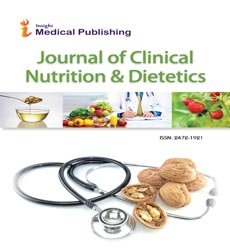Determination and Taking Care of Dietary Issues
Stephen Matthews*
Published Date: 2025-01-16Stephen Matthews*
Department of Nutrition and Health Science, Ball State University, Muncie, USA
- *Corresponding Author:
- Stephen Matthews
Department of Nutrition and Health Science,
Ball State University,
Muncie,
USA,
E-mail: Matthews.steve@gmail.com
Received date: February 01, 2024, Manuscript No. IPJCND-24-18600; Editor assigned date: February 05, 2024, PreQC No. IPJCND-24-18600 (PQ); Reviewed date: February 19, 2024, QC No. IPJCND-24-18600; Revised date: March 21, 2025, Manuscript No. IPJCND-24-18600 (R); Published date: March 28, 2025, DOI: 10.36648/2472-1921.11.2.157
Citation: Matthews S (2025) Determination and Taking Care of Dietary Issues. J Clin Nutr Diet Vol:11 No:2
Description
A dietary problem is a psychological problem characterized by strange eating ways of behaving that adversely influence an individual's physical or emotional wellness. Sorts of dietary issues incorporate gorging problem, where the patient eats a huge sum in a brief timeframe; anorexia nervosa, where the individual has an extraordinary anxiety toward putting on weight and confines food or over exercises to deal with this trepidation; bulimia nervosa, where people eat an enormous amount (gorging) then attempt to free themselves of the food (cleansing); pica, where the patient eats non-food things; rumination condition, where the patient spews undigested or negligibly processed food; avoidant/prohibitive food consumption jumble (ARFID), where individuals have a decreased or particular food admission because of a few mental reasons; and a gathering of other determined taking care of or dietary issues. Nervousness problems, misery and substance misuse are normal among individuals with dietary issues. These problems do exclude corpulence. Individuals frequently experience comorbidity between a dietary problem and OCD. It is assessed 20%-60% of patients with an ED have a background marked by OCD.The reasons for dietary issues are not satisfactory, albeit both natural and ecological elements seem to assume a part. Social glorification of slimness is accepted to add to some dietary problems. People who have encountered sexual maltreatment are likewise bound to foster dietary issues. A few problems, for example, pica and rumination issue happen all the more frequently in individuals with scholarly handicaps. Treatment can be powerful for the majority dietary issues. Treatment fluctuates by jumble and may include guiding, dietary counsel, decreasing inordinate activity, and the decrease of endeavors to dispose of food. Meds might be utilized to assist with a portion of the related side effects. Hospitalization might be required in additional serious cases. Around 70% of individuals with anorexia and half of individuals with bulimia recuperate in five years or less. Just 10% of individuals with dietary issues get treatment, and of those, roughly 80% don't get the appropriate consideration. Many are sent home weeks sooner than the suggested stay and are not furnished with the essential treatment. Recuperation from gorging problem is less clear and assessed at 20% to 60%. Both anorexia and bulimia increment the gamble of death. At the point when individuals experience comorbidity with a dietary problem and OCD, certain parts of treatment can be affected in a bad way. OCD can make it harder to recuperate from fixation on weight and shape, body disappointment, and body checking. This is to a limited extent since ED perceptions fill a comparable need to OCD fixations and impulses (e.g., wellbeing ways of behaving as transitory help from tension). Research shows OCD doesn't affect the BMI of patients during treatment.
Evaluations of the commonness of dietary problems change broadly, reflecting contrasts in orientation, age, and culture as well as strategies utilized for conclusion and estimation. In the created world, anorexia influences around 0.4% and bulimia influences around 1.3% of young ladies in a given year. Pigging out jumble influences around 1.6% of ladies and 0.8% of men in a given year. As per one examination, the percent of ladies who will have anorexia eventually in their lives might depend on 4%, or up to 2% for bulimia and pigging out messes. Paces of dietary problems seem, by all accounts, to be lower in less evolved nations. Anorexia and bulimia happen almost multiple times more frequently in females than guys. In spite of the fact that amenorrhea was a necessary model for a finding of anorexia in the DSM-IV, it was dropped in the DSM-5 because of its selective nature, as male, post-menopause ladies, or people who don't bleed for different reasons would neglect to meet this rule. Females with bulimia may likewise encounter amenorrhea, albeit the reason isn't clear. The psychopathology of dietary problems revolves around self-perception aggravation, like worries with weight and shape; self-esteem being too reliant upon weight and shape; feeling of dread toward putting on weight in any event, when underweight; forswearing of how serious the side effects are and a bending in the manner the body is capable.
Open Access Journals
- Aquaculture & Veterinary Science
- Chemistry & Chemical Sciences
- Clinical Sciences
- Engineering
- General Science
- Genetics & Molecular Biology
- Health Care & Nursing
- Immunology & Microbiology
- Materials Science
- Mathematics & Physics
- Medical Sciences
- Neurology & Psychiatry
- Oncology & Cancer Science
- Pharmaceutical Sciences
